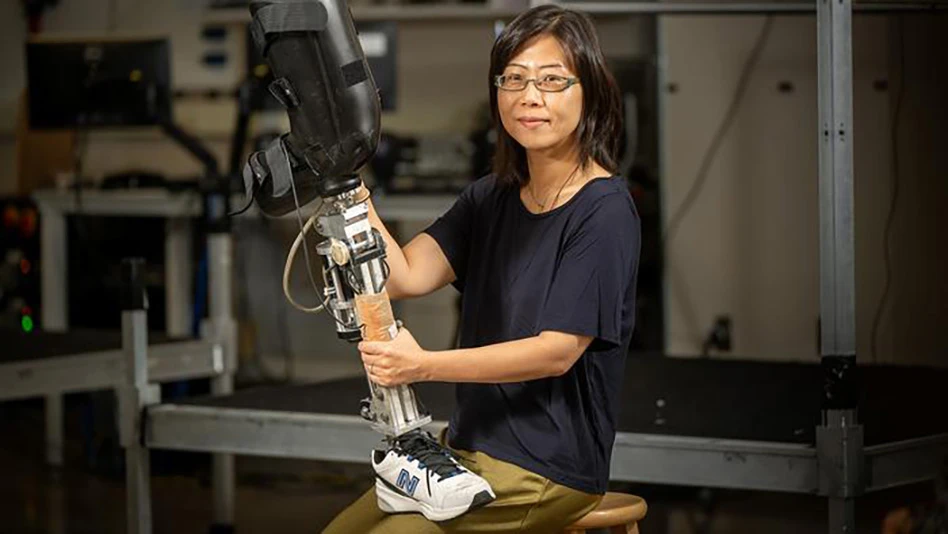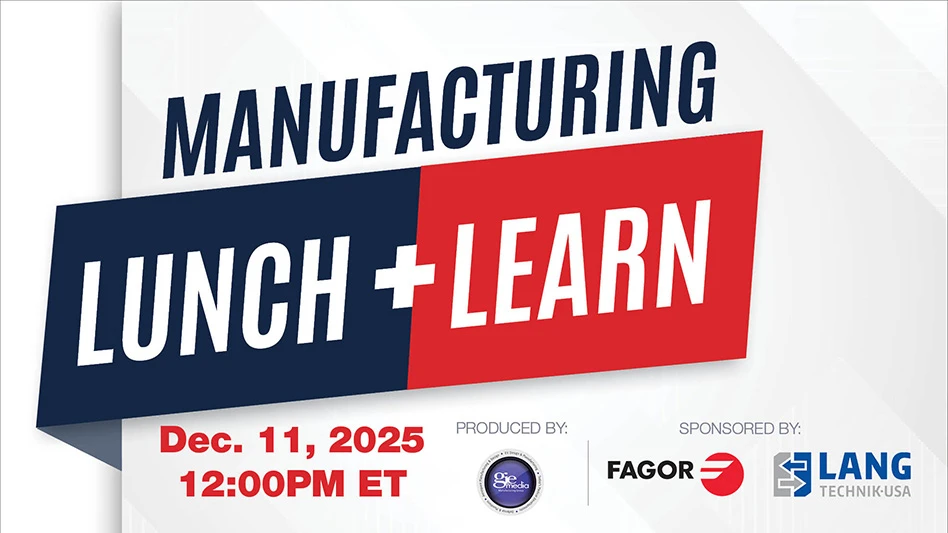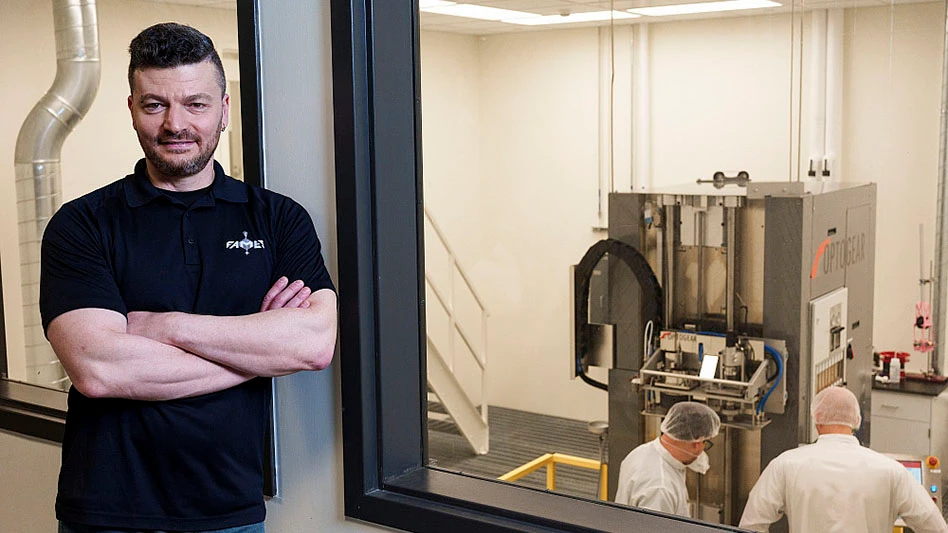
Shown is a cut through an additive-manufactured ceramic microreactor. The complex channels, as well as the fluidic connections at the top, were printed together with the whole component. (Credit: Fraunhofer Institute for Ceramic Technologies and Systems IKTS)
Dresden, Germany – Fraunhofer researchers have developed a particularly flexible additive manufacturing method that allows them to produce bone implants, dentures, surgical tools, or microreactors in almost any conceivable design. Scientists from Dresden showed their research results at the Medtec medical technology tradeshow in Stuttgart in April 2016.
The small pharmaceutical plant next to the patient’s bed is no bigger than a two euro coin. With wires and channels that are just a few hundred micrometers wide, it constantly mixes various drugs – painkillers, blood thinners, and antibiotics – and fine-tunes them to the patient’s current health condition. A futuristic scene of modern microreaction technology that doesn’t yet exist in hospitals. The Fraunhofer Institute for Ceramic Technologies and Systems IKTS in Dresden is working on changing that in the near future.
Processing different materials at the same time
The researchers from Dresden are focusing on suspension-based additive manufacturing methods and combinations of them with other manufacturing techniques to create not only microreactors, but also bone implants, dentures, and surgical tools. At Medtec they presented a technological solution for creating medical components in almost every conceivable design using additive manufacturing methods.
“We have no limitations in terms of type or color of material for the target components. This allows us to process ceramics, glass, plastic, or even metal using thermoplastic 3D printing. One more advantage is that several different materials can be produced at the same time,” says Dr. Tassilo Moritz from Fraunhofer IKTS’s Materials and Processes business division.
In the lab, the scientists have already successfully made components out of high-performance ceramics and hard metals. Now they are looking for partners to put their technology to real-world use.
One area in which the multi-material approach is important is surgery: endoscopes frequently employ an instrument to first cut open tissue, and then quickly close the blood vessels back up again using electric current. To prevent electricity from shocking the patient, the instrument needs not only high-grade steel but also insulated ceramic components.
“Ceramic substances are often well-suited for medical devices and components. Ceramics are sturdy and can be cleaned thoroughly,” Moritz explains.
It’s all in the recipe
Researchers arrived at their additive manufacturing method as a result of their expertise in ceramic materials and process technologies. The key to their technology lies in preparing optimum ceramic or metallic suspensions. The mixtures rely on a thermoplastic binder that becomes liquid at temperatures of around 80°C. This is a crucial point in additive manufacturing: it means the suspensions can quickly cool down and one layer after another can be deposited in sequence. In this binder, they disperse powder particles of metal, glass, or ceramics.
“Our mixtures are very homogenous and we precisely set the optimum level of viscosity. Only then can the printer put out the droplet size suitable for the particular component contour. Our mixtures can’t be too liquid or thick. To achieve this, we have to master the preparation technique,” Moritz says.
The electrically generated temperature in the printer melts the suspension. After deposition, the droplets immediately harden as a result of the quick cooling process. The workpiece is then built up point by point on a flat platform. This allows different materials to be deposited at the same time via multiple application units.
“Another challenge is adjusting the behavior of the different suspensions during the subsequent sintering of the components, to prevent any defects,” Moritz says. “To this end, we modify the initial powder through special grinding processes.” In sintering, finely grained ceramic or metallic substances are heated under pressure. The temperatures of the substances remain so low that the structure of the workpiece does not change.”
New options for microreaction technology
Moritz is hoping for great things from these new options for microreaction technology based on ceramic components. Until now, production technology has prevented a breakthrough in miniature chemical plants. Their use had previously been limited to research labs in the main.
That could change: “We can now build ceramic components that fit the application instead of the production process,” says the materials scientist. “To date, ceramic microreactors have mostly been milled out of plates. Internal and external sealing have always been a technological challenge for this. And there has been the problem of making connections that fit. Now we can just print them onto the ceramic component during manufacturing in whatever form.”
This benefits not only doctors, but also pharmacists and chemists. In most cases, they are processing very expensive or hazardous substances.
“It is more affordable and safer to first work with minimal quantities in a microreactor,” Moritz says.
EU Project CerAMfacturing
With funding from the European Union, the research project CerAMfacturing began in October 2015 and will run for a total of three years. Partners from industry and research are working together on instruments and components for personalized medicine. They are developing surgical tools such as grippers and forceps, implants for knee and spine, as well as heatable treatment agents for tailored joint therapies. As coordinator, the Fraunhofer Institute for Ceramic Technologies and Systems IKTS in Dresden is responsible for tasks including the development of additive manufacturing methods.
Source: Fraunhofer Institute for Ceramic Technologies and Systems IKTS
Latest from Today's Medical Developments
- GrindingHub Americas launches in 2027 in Cincinnati, Ohio
- Methods Machine Tools now offers the Nakamura-Tome NT-Flex
- Battelle awards $900,000 in STEM education grants to Ohio schools
- #55 Lunch + Learn Podcast with KINEXON
- Starrett and Gerstner offer limited edition, American made 1950s replica wooden machinist tool chests
- EMCO’s UNIVERSALTURN 50: The new benchmark in universal turning
- Archetype's Expertise for Equity accelerates early-stage innovation
- Stratasys expands its AM solutions with Tritone's cutting-edge technology





